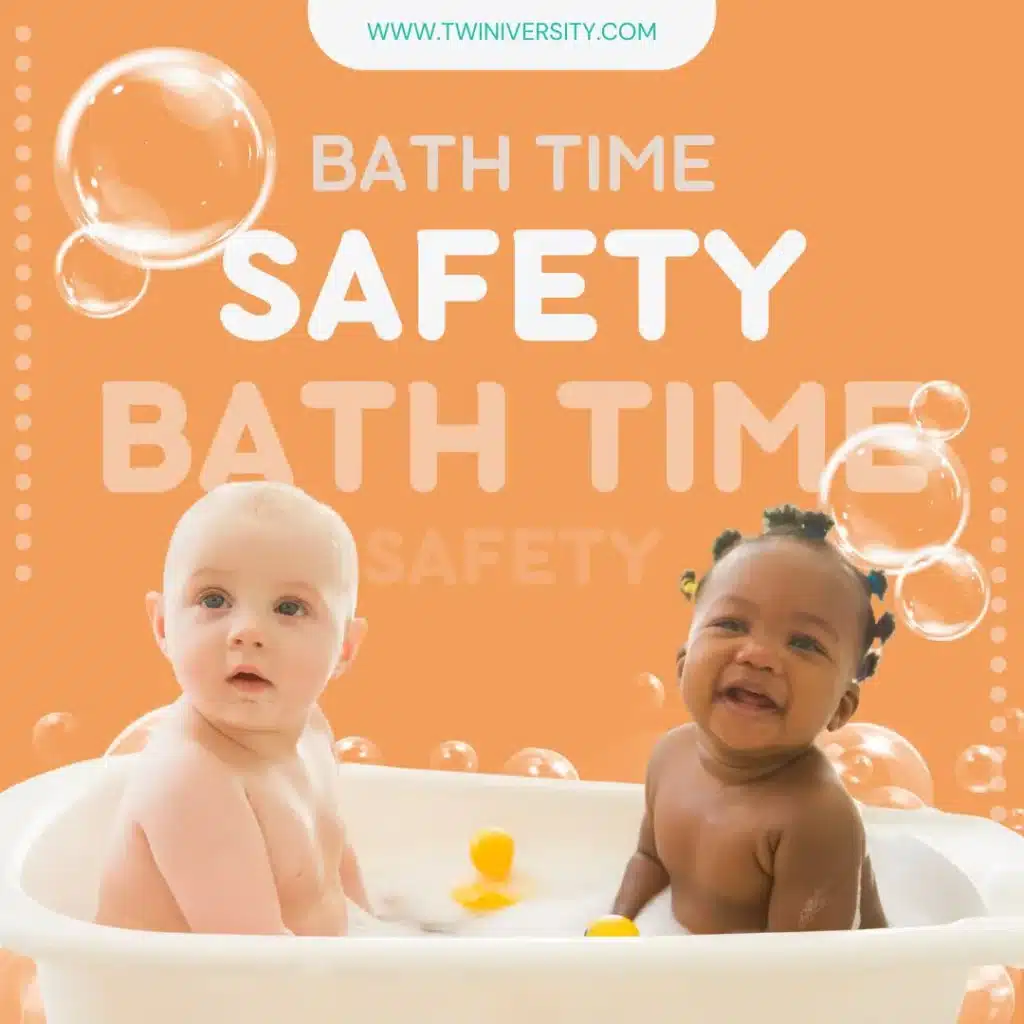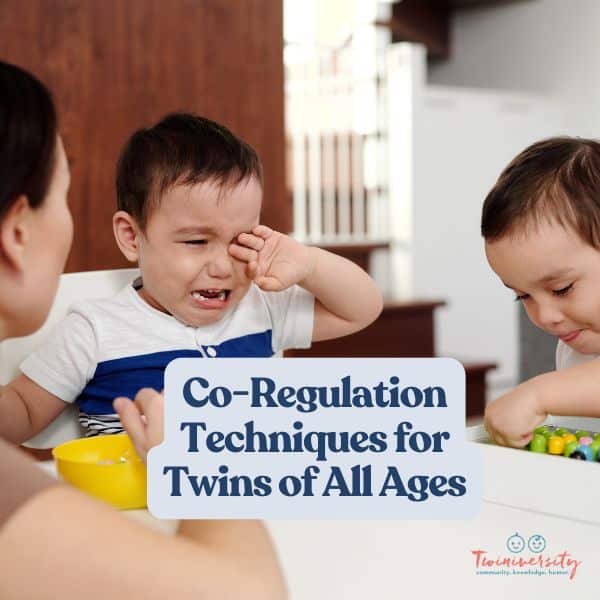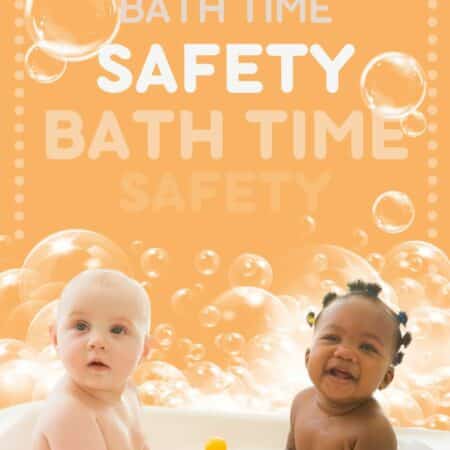
January is not just about resolutions and fresh starts; it’s also National Bath Safety Month! If you’re a parent of twins, you’re already familiar with the unique challenges and joys of “double” the fun. Bath time is no exception! Making sure it’s not just a splashy affair but a safe one, too, is key. Keep reading to learn all about bath time safety with your twinados!
Realising you have little ones transforms the once inviting, relaxing bathroom into a realm of endless potential hazards. That relaxing tub you once used for R&R now resembles more of the deep end of a pool (these are actual thoughts that ran through my head when I brought my twins home). When my twins finally graduated from the NICU, each weighing just under 6 lbs, I was sent home with no knowledge or instruction on how to give them a bath. The thought of bathing these two tiny humans terrified me. Thankfully, my Mother-In-Law (also a MoM) was by my side, coaching me and helping me. But what if you don’t have a MoM MIL?
The Truth about Bath Time Safety
I’m not trying to scare you, but the statistics around bathtub drowning must be discussed. According to the CDC, “for infants under the age of 1 year old, two-thirds of all drownings occur in bathtubs.”
The American Academy of Pediatrics said, “Approximately 15% to 30% of caregivers have reported leaving their children younger than 2 years unsupervised in the bath for a period ranging from a minute to slightly over five minutes.” These facts aren’t shared here to instill fear. Instead, they aim to raise awareness and assist in preparing you for one of the crucial aspects of your caretaking role as a parent to your two little blessings.
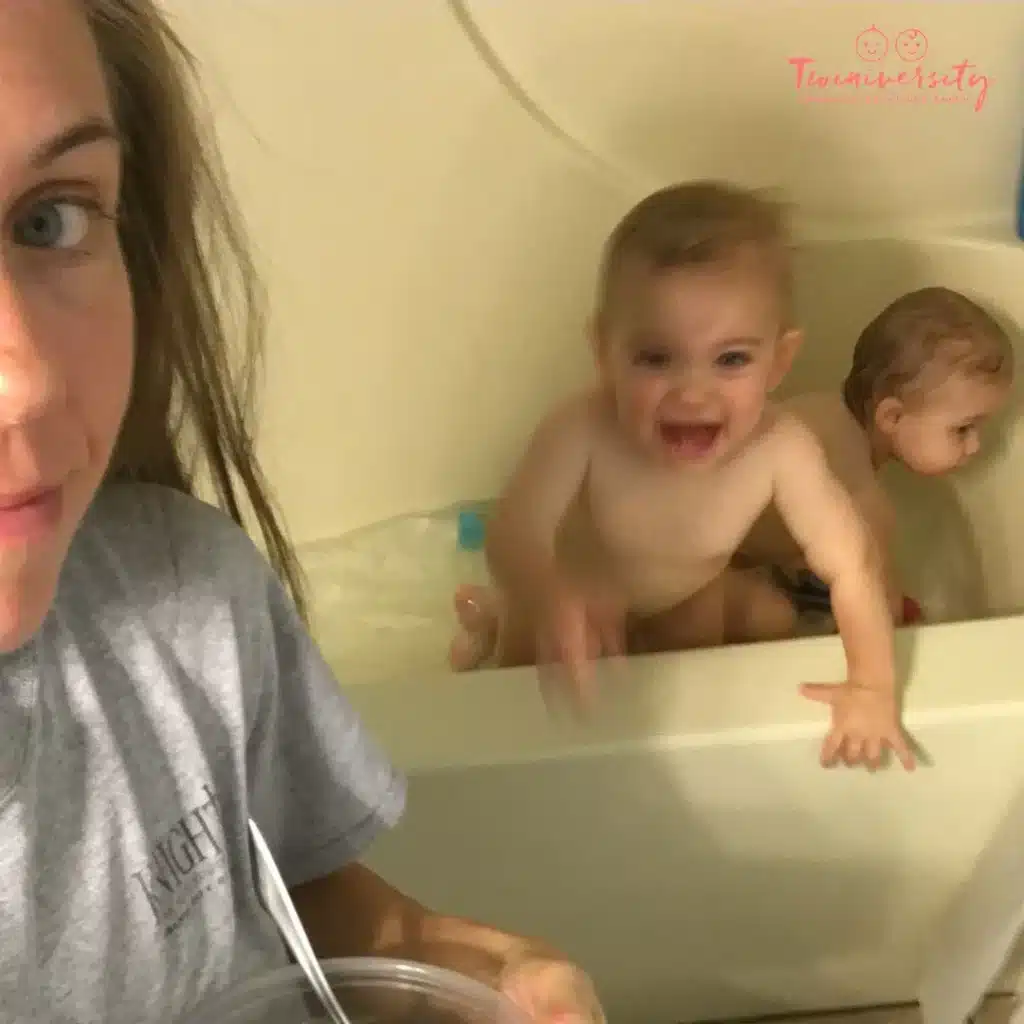
Bath Time Safety with Infants
Newborns
For newborns, it is recommended to establish an assembly line approach, bathing them one at a time while the other is attended to by the other parent. If this isn’t feasible, and you’re bathing them individually, ensure the other is secure in their crib or swing nearby. Twin bath time safety during this stage closely aligns with the safety measures taken during bath time for a single baby.
For the tiniest ones who can’t sit up on their own yet, go for a baby bath or a special infant tub. And remember, no multitasking during bath time! Your baby needs your full attention.
Be gentle when handling your little water explorer, especially around the head and neck. And hey, start with short baths and work your way up as they get used to the water world.

Got twins? Us too! The Twiniversity Podcast with Natalie Diaz was created BY parents of twins FOR parents of twins, from your pregnancy days through your twin’s teenage years, this podcast covers it all. It’s all about parenting twins, offering plenty of strategies for making life better, parenting hacks, and, of course, humor. We are laughing WITH you every step of the way.
6 months
To safely bathe 6-month-old twins, gather all supplies beforehand. Use a spacious baby tub with a non-slip surface or a regular bathtub with a non-slip mat. Set the water temperature to around 100°F. If possible, enlist the help of another caregiver for support. At this age considering tandem bathing for efficiency, but if that doesn’t work for you, then contunie with one baby at a time. Use supportive seats for sitting babies and maintain constant supervision throughout the process.
9 months +
Bathing 9-month-old twins involves constant supervision due to their increased mobility. Consider transitioning to the regular bathtub, use non-slip mats, and baby-proof the bathroom. Introduce interactive toys for a fun experience and maintain a dual bathing setup, ensuring each twin has their designated space. Continue using baby-approved products, encourage independence in water play, and keep bath time relatively short.
Consider your home arrangement and identify what makes you feel most at ease. Remember, your vigilant supervision during bath time is crucial for the safety of your babies. The tubs and inserts mentioned here are tools to assist during bath time, not substitutes for your watchful presence. Once you’ve decided on your designated area, ensure everything is ready beforehand. Having all the necessary items within arm’s reach will streamline the process and enhance safety.
Supplies
- Slip-proof bath mat
- Infant tub
- Infant/Baby soap/shampoo
- Washcloth
- Water cup or container of sorts to help with rinsing your baby
- Hooded towel
- Lotion
- Diaper
- Clothes
Now that you have these items, The American Academy of Dermatology Association suggest starting with a baby bath or a specialized infant tub filled with lukewarm water. Start with washing the baby’s head and keep one hand on the baby at all times (safety first).
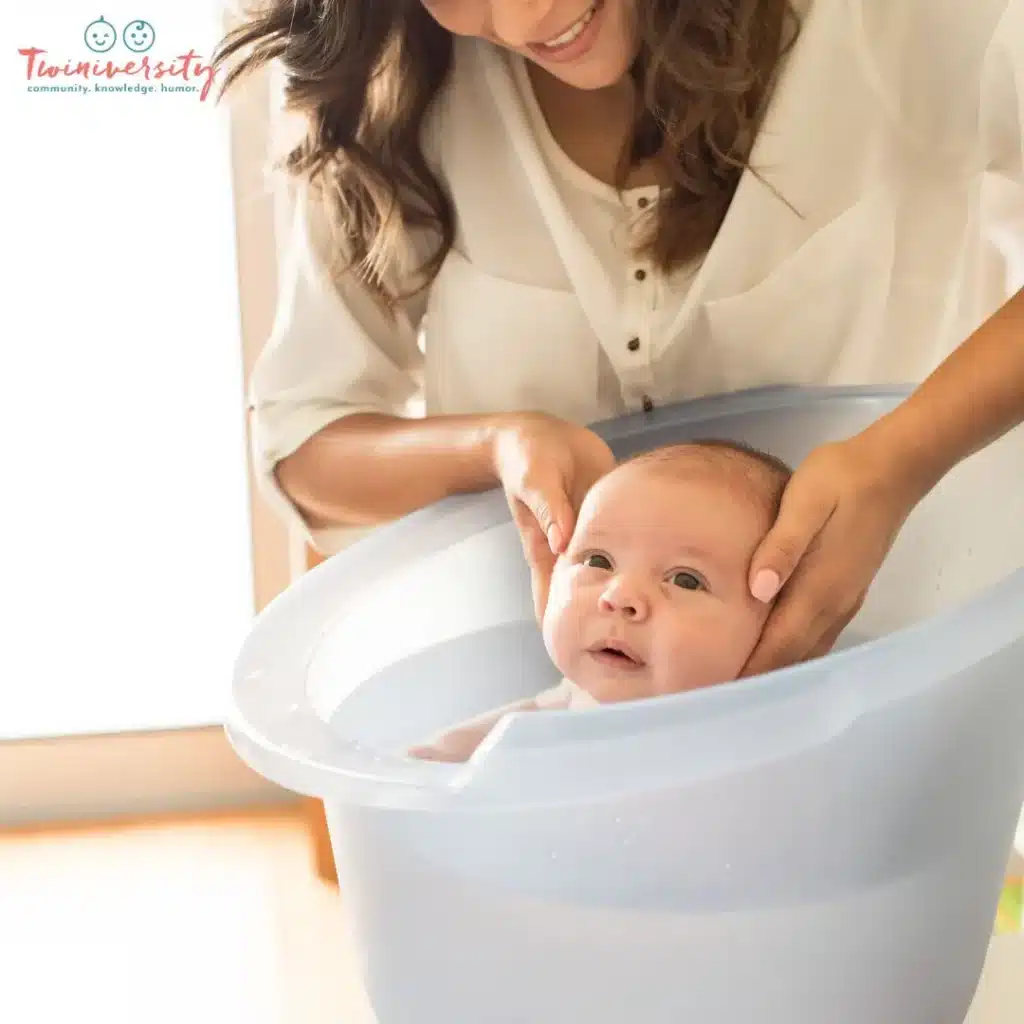
Water Tempurature
Bath water temperature is crucial for bath time safety. Maintaining the appropriate water temperature, around 98°F (36.67°C) to 100°F (37.8°C) for babies, ensures a safe and enjoyable bathing experience, minimizing the risk of burns or discomfort. Always check bath water tempuratures before putting your babies in the water.
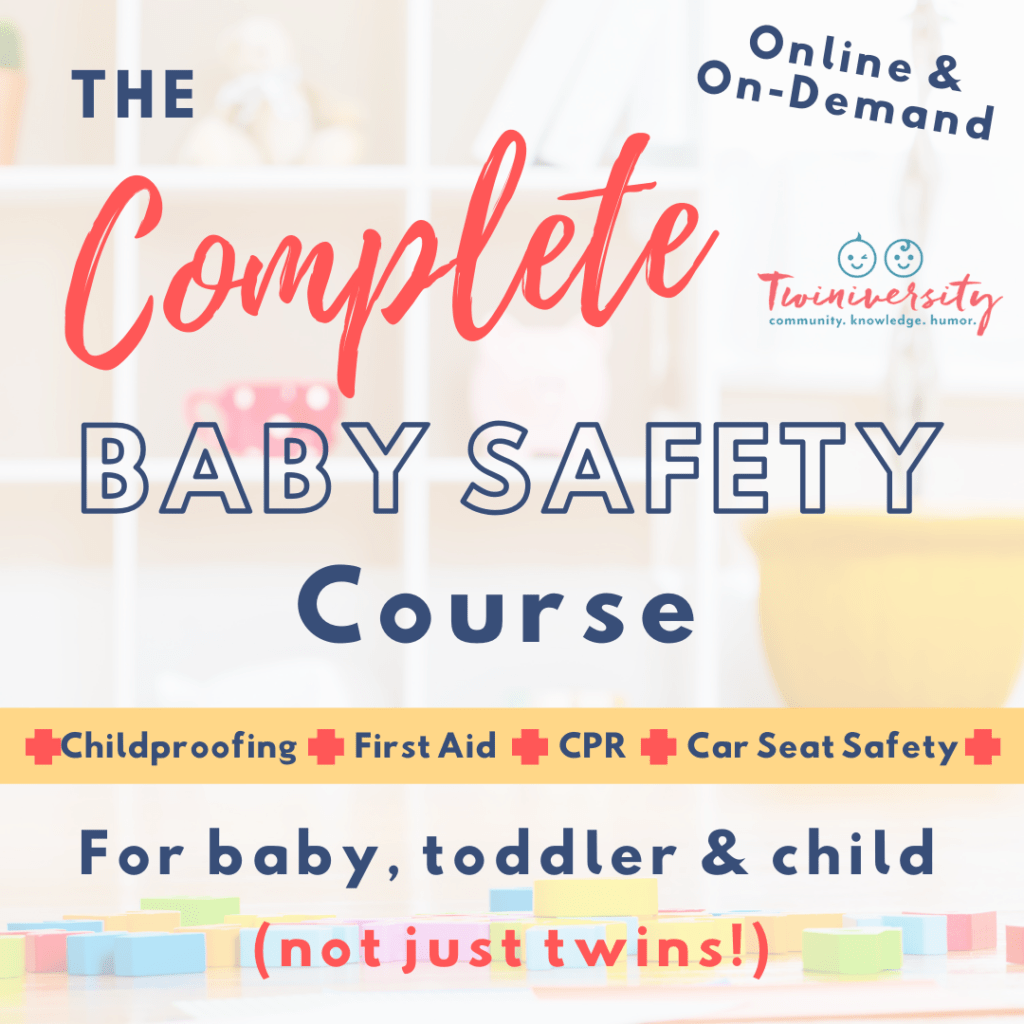
Need some baby safety training? Take the Twiniversity Complete Baby Safety course, offered on-demand. Includes video modules on infant, toddler, and child CPR, first aid, and common medical ailments, plus car seat installation and safety and childproofing your home. Click here to learn more!
How to test water tempurature
Use Your Wrist or Elbow: Test the water with your wrist or elbow. These areas are more sensitive to temperature than your hand. It should feel comfortably warm, not too hot or too cold.
Bath Thermometer: Consider using a bath thermometer designed specifically for checking water temperature. The ideal water temperature for a baby’s bath is between 98°F (36.67°C) and 100°F (37.8°C).
Baby bath tubs
Baby bath tubs are designed to make bathing enjoyable for your babies but also ensuring bath time safety. From inserts to supportive seats, there are a variety of choices tailored to different needs and preferences. Each option is crafted with features like non-slip surfaces and contoured designs, ensuring that your babies are comfortable and safe during bath time.
Sink Inserts
Sink inserts effectively transform your kitchen sink into a practical and comfortable bathing space for your babies. These inserts, akin to specialized pads, offer a structured and secure surface for your baby during bath time. By effortlessly placing them in the sink, you create an elevated and safe environment for bathing. Crafted from materials designed for both comfort and non-slip functionality, these inserts provide an efficient alternative to traditional baby bathtubs.
Basin Tubs
Utilizing a basin tub for bathing babies offers a convenient and safe solution for bath time. These specialized tubs, designed with the baby’s comfort and safety in mind, provide a supportive and contoured surface. Easily placed in sinks or other suitable areas, basin tubs create a dedicated space for bathing infants. With features like non-slip surfaces, they ensure a secure environment for the baby.
Support Seats
These specially designed seats provide stability and support for babies who can sit with minimal assistance. Easily placed in a standard bathtub, these seats ensure a secure and contoured space, allowing parents to focus on cleaning and interacting with their little ones. Supporting the baby’s posture, these seats make the bathing experience more manageable and enjoyable for both caregivers and infants.
When your twins can sit up without assistance, it’s time to introduce joint bathtub sessions, and you’ll likely discover they thoroughly enjoy the shared experience. However, always keep in mind the fundamental principles of bath safety: fill the tub with 2 to 3 inches of water, employ a non-slip bath mat, and remain within arm’s reach of your little ones at all times. Be ready for the unexpected with an emergency plan and know your baby CPR.
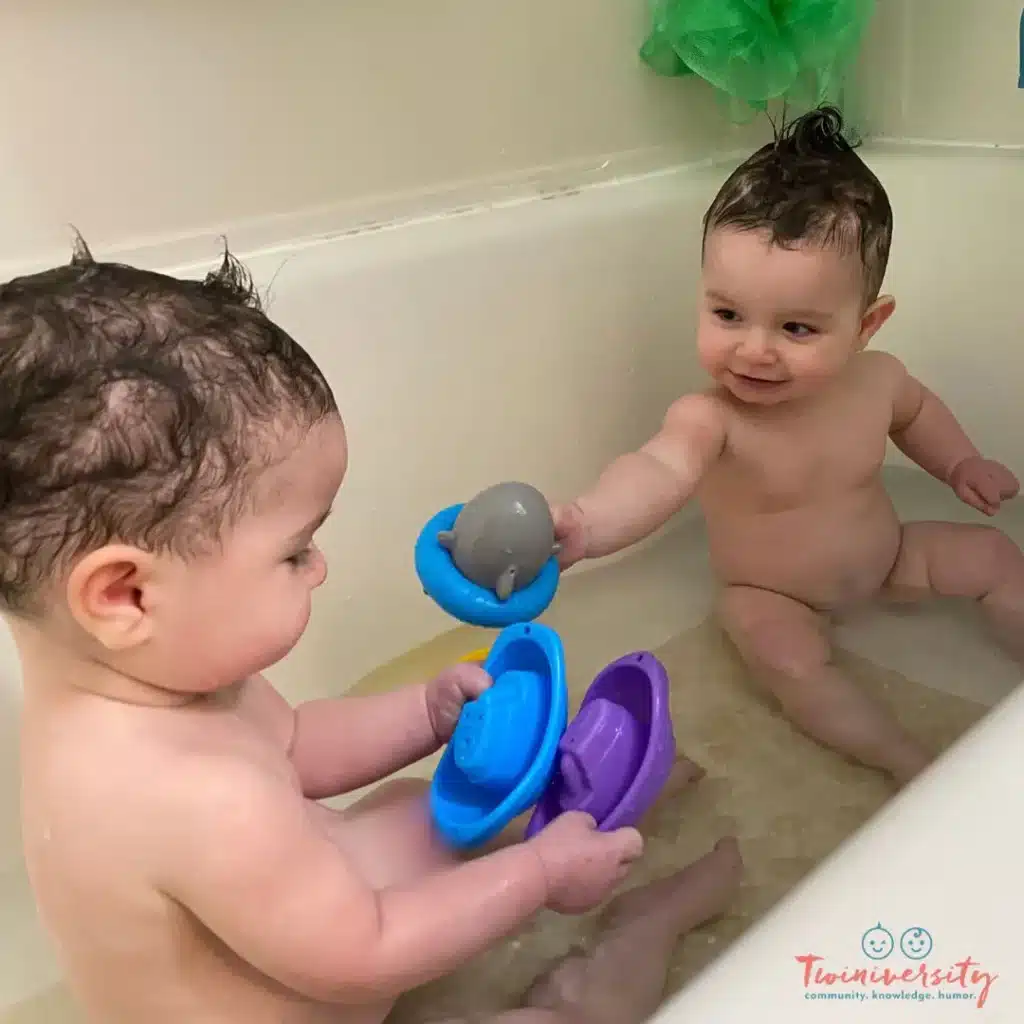
Wondering when you should stop bathing your boy/girl twins together? Read all about it here!
My anxiety-ridden fear of bath time slowly eased once we established the assembly line. I’d bathe one in our basin, rinse, dry, lotion, diaper, clothe and walk out of the bathroom. My husband will then take the other twinnie in and do the exact same routine. We also kept bath time at the same time every day since they were infants (just before bed) and now it has become part of the routine. Even though they said to bathe every 2-3 days to avoid drying out the skin, our twins loved their time in the water so we’d skip soap on the odd days and called it water days. Our evening ritual is known as the BBB’s (Bath, Book, Bed). This consistent routine has reinforced the foundations we’ve set during sleep training, but that is a story for another time!

Stephanie Miller is the proud mom of twin cyclones Zach and Carter (20-month-old). Every day in the Miller house, you’ll find rooms turned over, floors covered in bits of Lego and puzzle pieces (mind your step), and the sound of “Brown Bear Brown Bear” read over and over and over again. You’ll typically find her being used as the seat to reading time for the two bookworms, covered in bubble solution as they try to excel in their Bubble Wand skills, or being the voice to command Alexa for their favorite tunes. She and her husband are working on their traveling skills cause she can’t wait to show them the amazing world that is out there for them.

